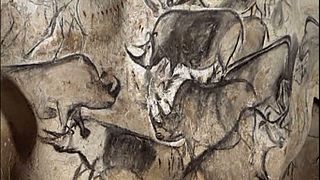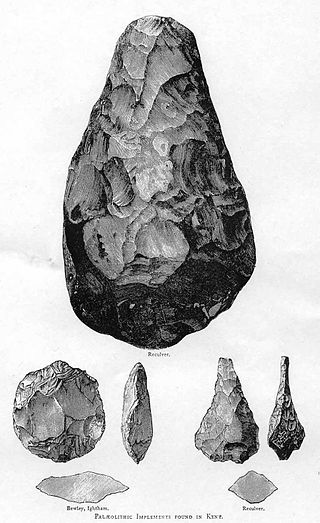Related Research Articles

Egyptian hieroglyphs were the formal writing system used in Ancient Egypt for writing the Egyptian language. Hieroglyphs combined logographic, syllabic and alphabetic elements, with more than 100 distinct characters. Cursive hieroglyphs were used for religious literature on papyrus and wood. The later hieratic and demotic Egyptian scripts were derived from hieroglyphic writing, as was the Proto-Sinaitic script that later evolved into the Phoenician alphabet. Through the Phoenician alphabet's major child systems, the Egyptian hieroglyphic script is ancestral to the majority of scripts in modern use, most prominently the Latin and Cyrillic scripts and the Arabic script, and possibly the Brahmic family of scripts.

An image is a visual representation of something. An image can be two-dimensional, such as a drawing, painting, or photograph, or three-dimensional, such as a carving or sculpture. Images may be displayed through other media, including projection on a surface, activation of electronic signals, or digital displays; they can also be reproduced through mechanical means, such as photography, printmaking or photocopying. Images can also be animated through digital or physical processes.

A pictogram, also called a pictogramme, pictograph, or simply picto, and in computer usage an icon, is a graphic symbol that conveys its meaning through its pictorial resemblance to a physical object. Pictographs are often used in writing and graphic systems in which the characters are to a considerable extent pictorial in appearance. A pictogram may also be used in subjects such as leisure, tourism, and geography.

In archaeology, cave paintings are a type of parietal art, found on the wall or ceilings of caves. The term usually implies prehistoric origin. These paintings were often created by Homo sapiens, but also Denisovans and Neanderthals; other species in the same Homo genus. Discussion around prehistoric art is important in understanding the history of the Homo sapiens species and how Homo sapiens have come to have unique abstract thoughts. Some point to these prehistoric paintings as possible examples of creativity, spirituality, and sentimental thinking in prehistoric humans.

In the history of art, prehistoric art is all art produced in preliterate, prehistorical cultures beginning somewhere in very late geological history, and generally continuing until that culture either develops writing or other methods of record-keeping, or makes significant contact with another culture that has, and that makes some record of major historical events. At this point ancient art begins, for the older literate cultures. The end-date for what is covered by the term thus varies greatly between different parts of the world.
Graphics are visual images or designs on some surface, such as a wall, canvas, screen, paper, or stone, to inform, illustrate, or entertain. In contemporary usage, it includes a pictorial representation of data, as in design and manufacture, in typesetting and the graphic arts, and in educational and recreational software. Images that are generated by a computer are called computer graphics.

Oracle bone script is an ancient form of Chinese characters that is the oldest known form of Chinese writing. Oracle bone writing was engraved on oracle bones, which were animal bones or turtle plastrons that were used in pyromantic divination during the late 2nd millennium BC. The vast majority of oracle bone inscriptions, of which about 150,000 pieces have been discovered, were found at the Yinxu site located in Xiaotun Village, Anyang, Henan Province. The latest significant discovery is the Huayuanzhuang storage of 1,608 pieces, 579 of which were inscribed, found near Xiaotun in 1993. They record pyromantic divinations of the last nine kings of the Shang dynasty, beginning with Wu Ding, whose accession is dated by different scholars at 1250 BC or 1200 BC. Oracle bone inscriptions of Wu Ding's reign have been radiocarbon dated to 1254–1197 BC±10 years. After the Shang were overthrown by the Zhou dynasty in c. 1046 BC, divining with milfoil became more common, and a much smaller corpus of oracle bone writings date from the Western Zhou. Thus far, no Zhou sites have been found with a cache of inscriptions on the same scale as that at Yinxu, although inscribed oracle bones appear to be more widespread, being found near most major population centers of the time, and new sites have continued to be discovered since 2000.

Chinese bronze inscriptions, also commonly referred to as bronze script or bronzeware script, are writing in a variety of Chinese scripts on ritual bronzes such as zhōng bells and dǐng tripodal cauldrons from the Shang dynasty to the Zhou dynasty and even later. Early bronze inscriptions were almost always cast, while later inscriptions were often engraved after the bronze was cast. The bronze inscriptions are one of the earliest scripts in the Chinese family of scripts, preceded by the oracle bone script.
Portable art refers to the small examples of Prehistoric art that could be carried from place to place, which is especially characteristic of the Art of the Upper Palaeolithic and Mesolithic eras. Often made of ivory, bone, antlers or stone, these pieces have been found in South Africa all the way up to Eurasia. It is one of the two main categories of Prehistoric art, the other being the immobile Parietal art, effectively synonymous with rock art.

Tsion Avital is an Israeli philosopher of art and culture.
Symbolic culture, or non-material culture, is the ability to learn and transmit behavioral traditions from one generation to the next by the invention of things that exist entirely in the symbolic realm. Symbolic culture is usually conceived as the cultural realm constructed and inhabited uniquely by Homo sapiens and is differentiated from ordinary culture, which many other animals possess. Symbolic culture is studied by archaeologists, social anthropologists and sociologists. From 2018, however, some evidence of a Neanderthal origin of symbolic culture emerged. Symbolic culture contrasts with material culture, which involves physical entities of cultural value and includes the usage, consumption, creation, and trade of objects.

Graphic communication as the name suggests is communication using graphic elements. These elements include symbols such as glyphs and icons, images such as drawings and photographs, and can include the passive contributions of substrate, colour and surroundings. It is the process of creating, producing, and distributing material incorporating words and images to convey data, concepts, and emotions.

Paleolithic religions are a set of spiritual beliefs and practices that are theorized to have appeared during the Paleolithic time period. Paleoanthropologists Andre Leroi-Gourhan and Annette Michelson believe unmistakably religious behavior emerged by the Upper Paleolithic, before 30,000 years ago at the latest, but behavioral patterns such as burial rites that one might characterize as religious — or as ancestral to religious behavior — reach back into the Middle Paleolithic, as early as 300,000 years ago, coinciding with the first appearance of Homo neanderthalensis and possibly Homo naledi.

The rock drawings in Valcamonica are located in the Province of Brescia, Italy, and constitute the largest collections of prehistoric petroglyphs in the world. The collection was recognized by UNESCO in 1979 and was Italy's first recognized World Heritage Site. UNESCO has formally recognized more than 140,000 figures and symbols, but new discoveries have increased the number of catalogued incisions to between 200,000 and 300,000. The petroglyphs are spread on all surfaces of the valley, but concentrated in the areas of Darfo Boario Terme, Capo di Ponte, Nadro, Cimbergo and Paspardo.
This timeline of prehistory covers the time from the appearance of Homo sapiens approximately 315,000 years ago in Africa to the invention of writing, over 5,000 years ago, with the earliest records going back to 3,200 BC. Prehistory covers the time from the Paleolithic to the beginning of ancient history.

The Venus of Hohle Fels is an Upper Paleolithic Venus figurine made of mammoth ivory that was unearthed in 2008 in Hohle Fels, a cave near Schelklingen, Germany. It is dated to between 42,000 and 40,000 years ago, belonging to the early Aurignacian, at the very beginning of the Upper Paleolithic, which is associated with the earliest presence of Cro-Magnon in Europe.

The oldest undisputed examples of figurative art are known from Europe and from Sulawesi, Indonesia, dated about 35,000 years old . Together with religion and other cultural universals of contemporary human societies, the emergence of figurative art is a necessary attribute of full behavioral modernity.

The art of the Upper Paleolithic represents the oldest form of prehistoric art. Figurative art is present in Europe and Southeast Asia, beginning between about 40,000 to 35,000 years ago. Non-figurative cave paintings, consisting of hand stencils and simple geometric shapes, are somewhat older, at least 40,000 years old, and possibly as old as 64,000 years. This latter estimate is due to a controversial 2018 study based on uranium-thorium dating, which would imply Neanderthal authorship and qualify as art of the Middle Paleolithic.

The following outline is provided as an overview of and topical guide to prehistoric technology.